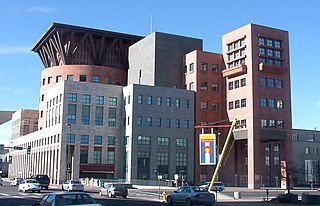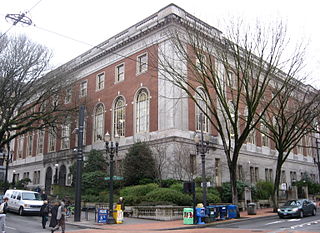
Lynchburg is an independent city in the Commonwealth of Virginia in the United States. First settled in 1757 by ferry owner John Lynch, the city's population was 79,009 at the 2020 census, making Lynchburg the 11th most populous city in Virginia. Located in the foothills of the Blue Ridge Mountains along the banks of the James River, Lynchburg is known as the "City of Seven Hills" or the "Hill City". In the 1860s, Lynchburg was the only city in Virginia that was not recaptured by the Union before the end of the American Civil War.

The Los Angeles Public Library system (LAPL) is a public library system in Los Angeles, California. The system holds more than six million volumes, and with around 19 million residents in the Greater Los Angeles area, it serves the largest metropolitan population of any public library system in the United States. The system is overseen by a Board of Library Commissioners with five members appointed by the mayor of Los Angeles in staggered terms, and operates 72 library branches throughout the city. In 1997 a local historian described it as "one of the biggest and best-regarded library systems in the nation." It is not to be confused with the LA County Library system which operates several library branches across certain areas of Los Angeles County.

The Denver Public Library is the public library system of the City and County of Denver, Colorado. The system includes the Denver Central Library, located in the Golden Triangle district of Downtown Denver, as well as 25 branch locations and two bookmobiles. The library's collection totals more than 2 million items, including books, reference materials, movies, music, and photographs. Of that total, more than 347,000 items are in specific collections including the Western History and Genealogy Department, Blair-Caldwell African American Research Library, and Reference Department holdings.

Virginia University of Lynchburg (VUL) is a private historically black Christian university in Lynchburg, Virginia. The university is accredited by the Transnational Association of Christian Colleges and Schools and offers instruction and degrees, primarily in religious studies, including a Doctorate of Ministry program. The campus is a historic district listed on the National Register of Historic Places.

Anne Bethel Spencer was an American poet, teacher, civil rights activist, librarian, and gardener. She was a prominent figure of the Harlem Renaissance, also known as the New Negro Movement, despite living in Virginia for most of her life, far from the center of the movement in New York. She met Edward Spencer while attending Virginia Seminary in Lynchburg, Virginia. Following their marriage in 1901, the couple moved into a house he builtArchived 2020-11-30 at the Wayback Machine at 1313 Pierce Street, where they raised a family and lived for the remainder of their lives.

Claude and Starck was an architectural firm in Madison, Wisconsin, at the turn of the twentieth century. The firm was a partnership of Louis W. Claude (1868-1951) and Edward F. Starck (1868-1947). Established in 1896, the firm dissolved in 1928. The firm designed over 175 buildings in Madison.

William Daniel, Jr. was an American slaveowner, lawyer, legislator and jurist who served on the Virginia Supreme Court of Appeals, that state's highest court, from 1846 to 1865.

Kenmore, also known as Kenmore Plantation, is a plantation house at 1201 Washington Avenue in Fredericksburg, Virginia. Built in the 1770s, it was the home of Fielding and Betty Washington Lewis and is the only surviving structure from the 1,300-acre (530 ha) Kenmore plantation.

The Connecticut State Library is the state library for the U.S. state of Connecticut and is also an executive branch agency of the state. It is located in Hartford, Connecticut directly across the street from the Connecticut State Capitol. The State Library provides a variety of library, information, archival, public records, museum, and administrative services to the citizens of Connecticut, as well as the employees and officials of all three branches of state government. Students, researchers, public libraries and town governments throughout the state are also served by the State Library. In addition, the State Library directs a program of statewide library development and administers the Library Services Technology Act state grant. "The mission of the Connecticut State Library is to preserve and make accessible Connecticut's history and heritage and to advance the development of library services statewide."

Hills Memorial Library is the former public library of Hudson, New Hampshire, in the United States. It was erected in memory of Ida Virginia Hills by her husband, Dr. Alfred Hills, and her mother, Mary Field Creutzborg. The land had been previously donated by Kimball Webster for the express purpose of building a public library. The new building was designed by architect Hubert G. Ripley, built during the winter of 1908–09 and opened to the public on June 12, 1909. The building was added to the National Register of Historic Places in 1984, and the New Hampshire State Register of Historic Places in 2012. The town of Hudson closed the facility on May 18, 2009, as the library collection was moved to the new George H. and Ella M. Rodgers Memorial Library.

The Central Library is a three-story public library branch in the downtown core of Portland, Oregon, United States. Opened in 1913, it serves as the main branch of the Multnomah County Library system. In 1979, the Georgian style building was added to the National Register of Historic Places as the Central Building, Public Library. The library underwent major structural and interior renovations in the mid 1990s.

The Peabody Institute Library is the public library serving Peabody, Massachusetts. It was established in 1852 by a bequest from philanthropist and Peabody native George Peabody, and now has its main facility at 82 Main Street, with the South Branch at 78 Lynn Street and West Branch at 603 Lowell Street. The main library is housed in a two-story brick building built in 1853 which is now listed on the National Register of Historic Places. The library is claimed to be the oldest public library in the United States to operate continuously from the same location.

Toledo Lucas County Public Library is a public library system located in Toledo, Ohio.

The Rivermont Historic District is a national historic district located in Lynchburg, Virginia. It is a 192.10-acre (0.7774 km2) district consisting of the 300-3400 blocks of Rivermont Avenue as well as Riverside Park and a few properties alongside streets that face onto Rivermont Avenue. It is bounded by the James River on the east and northeast, Blackwater Creek on the east and southeast, Daniel's Hill on the north and Virginia Episcopal Road and the southern end of Boonesboro Road.

The El Paso Public Libraries is the municipal public library system of El Paso, Texas. The library serves the needs the public in El Paso, Texas, Chaparral, New Mexico and Ciudad Juarez, Mexico. It consists of 14 branches and one Bookmobile service. Multiple outreach services are also available including a Homebound service.

The first Newport News Public Library, renamed West Avenue Library, now NNPLS Technical Services, in the Newport News Public Library System, was opened on October 14, 1929 at the corner of West Avenue and 30th Street in the City of Newport News, Virginia. This building was the first to be built in Newport News for the express purpose of being a library. In 2005, the West Avenue Library was placed onto the Virginia Landmarks Register and the National Register of Historic Places under its original name of Newport News Public Library. The building now known as West Avenue Library; however it is no longer a functioning library.

The Lakeland Public Library is a public library located in Lakeland, Florida, within Polk County, Florida. The library has three branch locations and is a member of the Polk County Library Cooperative (PCLC).
Frye and Chesterman was an American architectural firm formed in 1900 by partners Edward Graham Frye (1870–1942) and Aubrey Chesterman (1874–1937) with offices in Lynchburg, Virginia. In 1913 the firm moved to Roanoke, Virginia.

Jane Maud Campbell was a librarian known for being an early advocate for multiculturalism in libraries through her service to immigrant and minority populations. Campbell believed in cultural pluralism–that there was no one "American culture"–so while she supported immigrants' learning English and eventually becoming citizens, she was supportive of them maintaining their own cultures and interests.






















